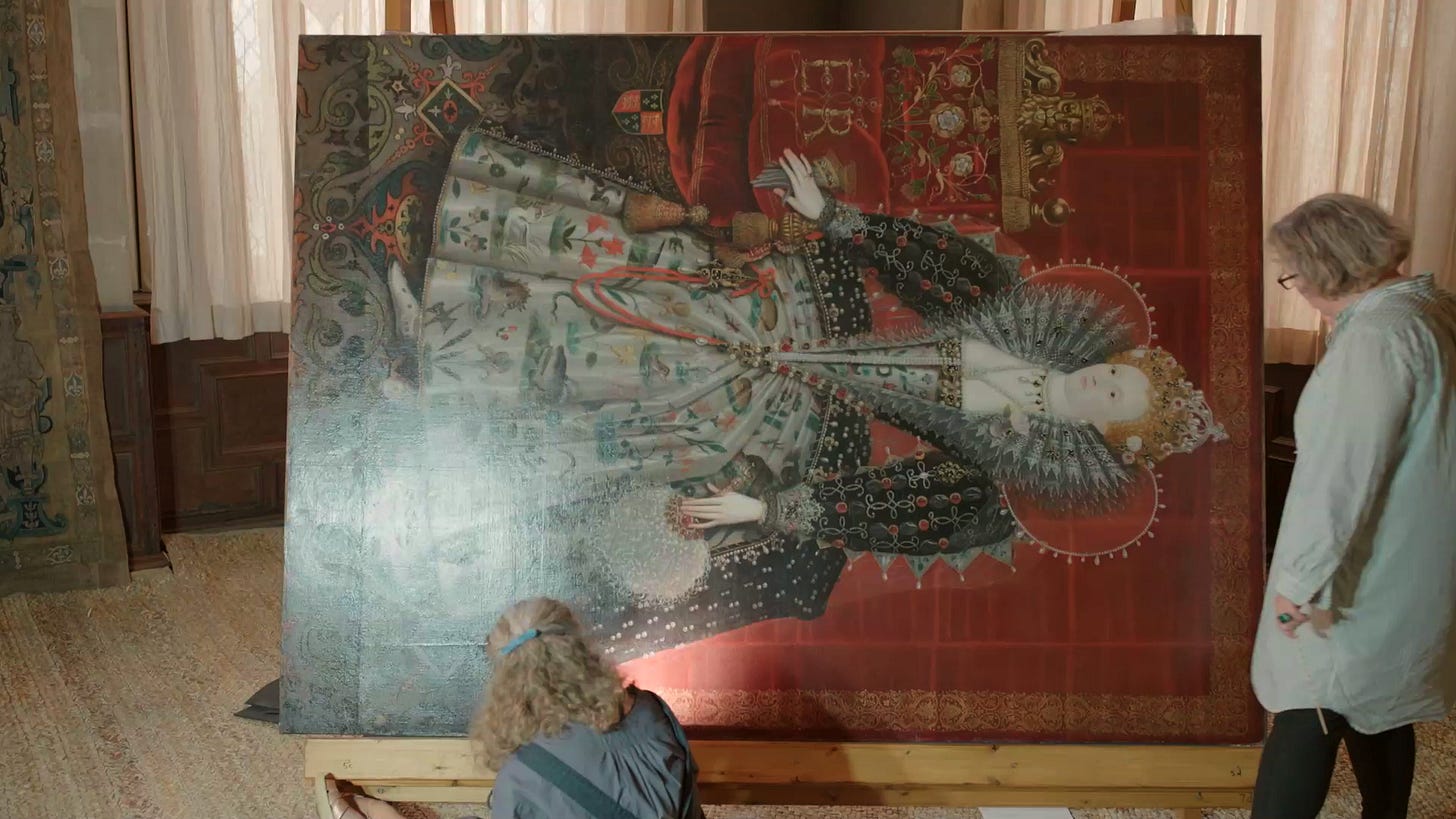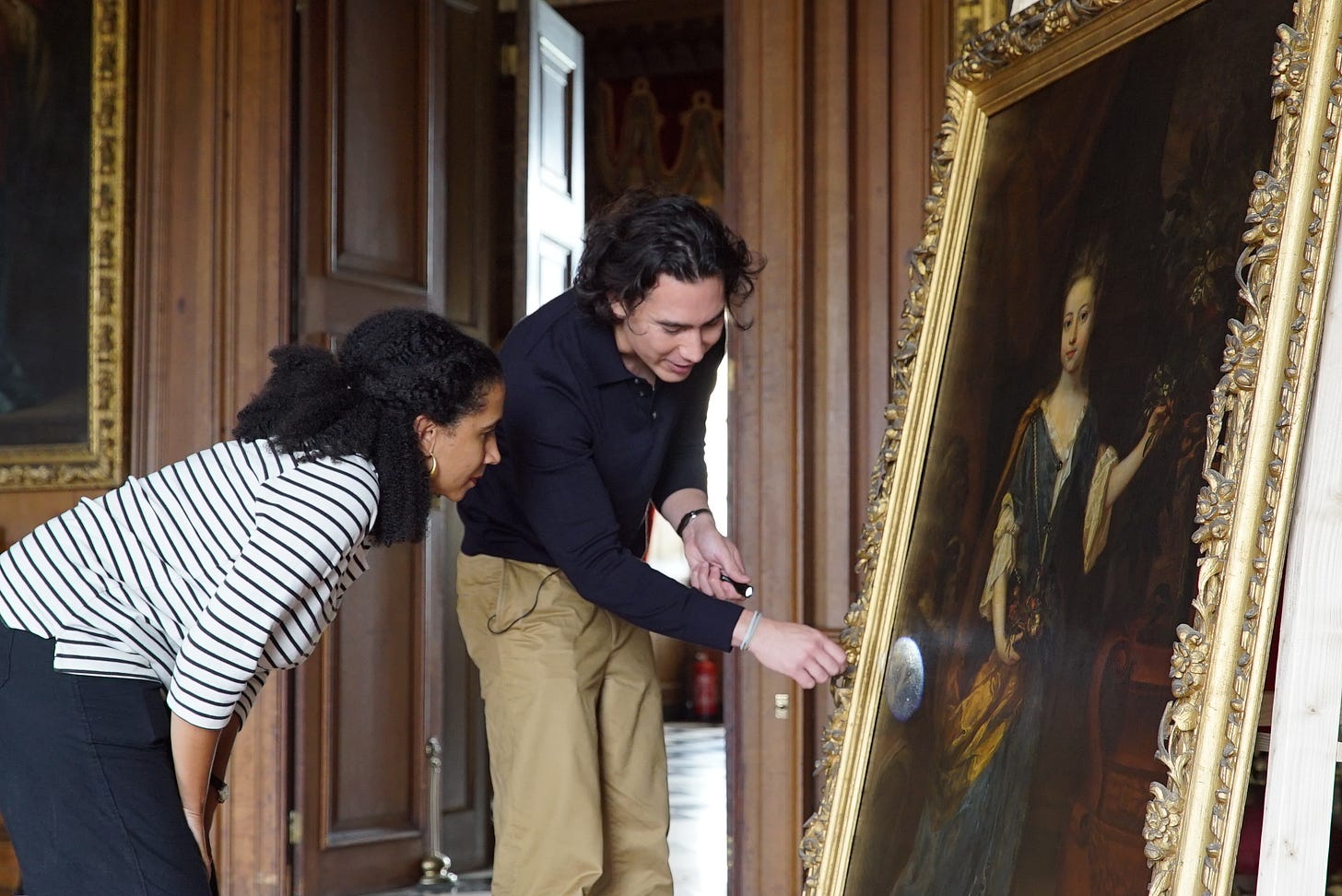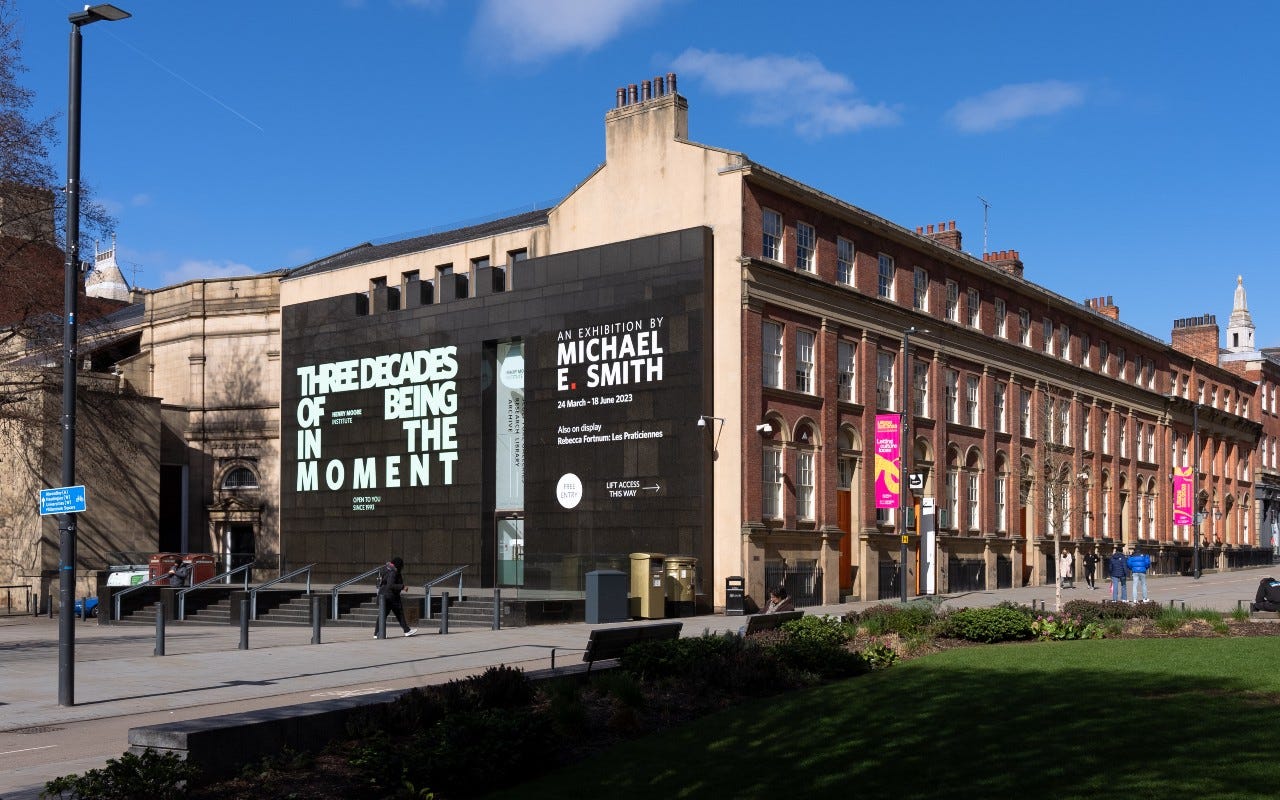Treasures on TV
Ahead of a major new BBC series on the National Trust, three expert staff talk about their work with Elizabethan masterpieces
“It’s exciting to share our world of close examination and what it all means”
Also in this edition: Laurence Sillars reflects on 30 years of the Henry Moore Institute
— First time here? Subscribe to never miss an edition
The Big Interview
A new BBC TV series is going behind the velvet rope at the country’s most beautiful and historic homes, to meet the people looking after our priceless heritage.
Hidden Treasures of the National Trust will be broadcast weekly on BBC Two in the UK at 9pm across the next six weeks. (You’ll be able to watch live and catch up on BBC iPlayer.)
It all kicks off tomorrow, and the series opener brings three of the Trust’s properties from the Midlands into focus. One of those is the Elizabethan masterpiece Hardwick Hall in Derbyshire. The programme will follow the Hall’s staff as they prepare for two of the property’s star items to go on loan to last year’s Metropolitan Museum of Art exhibition The Tudors: Art and Majesty in Renaissance England.
The first treasure — one of the finest surviving portraits of Elizabeth I — is known as the ‘Sea Monster’ painting for its depiction of mythological sea creatures on the queen’s dress. It’s down to property curator Liz and senior paintings conservator Rebecca to make sure Elizabeth is safe and fit to travel, while still looking her best for this once-in-a-lifetime trip.
The painting is joined on the transatlantic crossing by the ‘Sea-Dog’ table, named after the strange and wonderful creatures that adorn each leg, and considered to be the most important table in England. To ensure it survives the journey, the table must be taken to pieces and given a full health check, under the careful eye of conservator Gerry.
For this week’s Big Interview, maxwell museums speaks to Liz, Rebecca and Gerry from Hardwick Hall to get their insights into these Tudor masterpieces, and to find out what it was like going in front of the camera.
***
Liz Waring, property curator, Hardwick Hall
Why is the Elizabeth I ‘Sea Monster’ portrait so special?
The portrait is a symbol of the close acquaintance between Elizabeth I and Bess of Hardwick (who commissioned the Hall and was one of the richest women of her time), and it’s hung at Hardwick since it was brought here in 1599. It’s listed in the 1601 inventory.
It was painted when Elizabeth I was in her 60s. Although her ornate dress looks fantastical, with the underskirt decorated with flowers and land and sea creatures, there’s no reason to think the Queen didn’t own something similar. Elizabeth had one of the most extensive and lavish wardrobes of all time, and as late as 1599 she was described as “most gorgeously apparelled”.
The outfit is also covered in hundreds of pearls, a symbol of purity suitable for a virgin queen. It’s possible that Bess masterminded the design of the embroidery, and possibly worked on it herself, intending it to be a spectacular New Year’s Day gift to the Queen.
How did the Elizabeth portrait end up at Hardwick Hall?
It’s likely that it was commissioned by Bess and is the painting recorded as being transported to Hardwick from London in July 1599 in Chatsworth’s Archive in the Hardwick accounts. Bess had a close acquaintance with Queen Elizabeth, having been a Lady of the Privy Chamber, and the Queen even sided with Bess over her estranged husband. This painting represents their relationship — as well as showing Bess’ allegiance to her monarch.

What was it like being filmed for the BBC series?
Being filmed in the Hall was enjoyable, as the team was observing what we were already doing, although we had to be very organised to make sure everything went to plan. The sit-down interview was slightly more nerve-racking!
Why should people visit Hardwick Hall?
Hardwick Hall is the home of an incredible woman, Elizabeth, Countess of Shrewsbury (Bess), who rose from minor gentry to the Queen’s inner circle through her ambition, personality and strength. The Hall is a rare survival of English Renaissance architecture boasting a near-intact Elizabethan interior - the top floor in particular remaining almost unchanged since it was built.
It holds an internationally significant collection of textiles, furniture and portraits, many of which are still located in the same rooms as when Bess lived here, and they reflect the quality of craftsmanship, cultural mix, and complex relationships of the Elizabethan age. You can’t help but be enthralled as you walk through her spaces and experience her realm!
Rebecca Hellen, Senior National Conservator, Paintings at the National Trust
What goes into checking these treasures to see if they are fit to travel? What are you looking for?
With paintings you are looking to check that no areas are vulnerable during transport and installation/deinstallation with its core structure. Inspecting the back and the sides of the canvas and tacking edges as well as the front is essential to this. To ensure the canvas moves as little as possible during transport a modern fabric is cleverly applied at the reverse to sit tight like a drum between the canvas and the stretcher. This ‘stretcher bar lining’ reduces the vibrations experienced during travel in tandem with the careful cushioned, sealed casing. It is acting as a physical barrier but also creating an air cushion.
Once this is in place at the front across the paint surface all the networks of age cracks natural to a painting in oil of this age are looked over with a strong light raking light from the side using magnification. Of course loose dust was removed and a general surface clean carried out. Happily the varnish was in relatively good condition so no adjustments were made this time. Even taking the painting down and undoing it from its frame is an enormous job carried out by a trained, accredited frames conservator — with reframing, then photography and a report the final flourish.
The condition report travels like a passport with the object, so that our fellow conservators at all of the different venues it goes to can carefully check to see if anything changes on either the painting or frame.
What was it like being filmed for the BBC series?
I’ve always enjoyed communicating, so I thoroughly enjoyed the filming. The storytelling that conservators have, and the knowledge we have to share, is a glorious part of what we do. The making informs the meaning and I think audiences connect to that just as much as the incredible social, political and visual connections that shine through. It’s exciting to share our world of close examination and what it all means.
Gerry Alabone, furniture conservator at the National Trust
Why is the ‘Sea-Dog’ table so special?
The Sea Dog table is special because of the superb quality of design, carving, and its age. The table is based on the designs of Jacques Androuet du Cerceau (1510-1584), an important designer of architecture and ornament, including furniture; the four sea dogs are a direct copy of a Du Cerceau engraving.
A high-status piece of furniture, it was imported directly into England from France, and connected to Bess and Hardwick Hall’s Withdrawing Chamber (a reception room off the High Great Chamber) since before 1601. The table has been in continuous use and care for over the last 400 years, and is still considered stable enough to travel across the Atlantic to the United States, a country not dreamt of when it was made!
What goes into checking these items to see if they are fit to travel? What are you looking for?
The table comprises 17 components, and is complex to assemble. Several of its elements, such as the slender balusters and turtle feet, are functioning under load when they’re assembled, and the packing and transport involves considerable handling. All the components need examining, and in some cases consolidating, before they were transported, and some adjustments were made to its dowels for fitting. Additionally, the order of assembly was rationalised and detailed instructions were made describing unpacking, handling, assembly, disassembly and packing.
Hidden Treasures of the National Trust starts on BBC Two tomorrow at 9pm
The Big View
Leeds' Henry Moore Institute — the sculpture centre inspired by the great British artist — has just turned 30. Here, the Institute's Head Laurence Sillars reflects on the centre's achievements over the past three decades, and how they plan to celebrate.
“This year, the Henry Moore Institute reached the great milestone of 30 years since opening.
Part of the wider Henry Moore Foundation, the Institute launched in Leeds on 21 April 1993 as a centre for the study of sculpture with galleries for temporary exhibitions and a research library.
The Institute grew from the vision of Henry Moore, and latterly his daughter Mary, as part of his desire to give back to the county of his birth and the city where he studied.
Following the First World War, Moore received an ex-serviceman’s grant which enabled him to enrol at Leeds College of Art (now Leeds Arts University). When he began his year-long sculpture course in 1920, the sculpture department was established with Moore as its only student.
Moore struggled to see sculpture locally during his studies. Speaking in 1981, he recalled “as a young sculptor, there was nothing; there wasn’t a single piece of sculpture in my hometown.”
His vision changed that and we are proud to continue his legacy, providing a place for everyone to experience, study and enjoy sculpture from around the world for free.
The Institute and Yorkshire
Yorkshire is the home of sculpture in this country and we work alongside many partner organisations including The Hepworth Wakefield and Yorkshire Sculpture Park to continue our commitments to sculptors today and of the past through exhibitions and acquisitions.
In Leeds, our work is expanded through a unique partnership with Leeds Art Gallery to manage the sculpture collection and archive of Leeds Museums and Galleries, a collaboration that has built one of the strongest public collections of sculpture in Britain. We have made 700 acquisitions with Leeds City Council for Leeds’ Sculpture Collection, along with a significant number of works on paper.
Recently, through a special partnership with Contemporary Art Society and Cathy Wills, we have purchased works by Emii Alrai, Phyllida Barlow, Hew Locke and Ro Robertson, continuing our commitment to both established and younger sculptors working in Britain.
Welcoming 1 million visitors
Over the past 30 years, we have displayed the work of 731 artists from around the world, presented 224 exhibitions, acquired 30,000 books, publications, journals, audio-visual resources and ephemera in the Sculpture Research Library, hosted 140 Visiting Research Fellows in the Library and Archive of Sculptors’ Papers, alongside the works acquired for the collection.
We have welcomed over one million visitors and given numerous artists their first solo exhibition.
To celebrate our 30th birthday, we have a display looking at the making of the building — A Site for Sculpture: Building the Institute — which runs until 7 July.
We are also running a competition that invites anyone to redesign the facade of our building — something of a sculpture in its own right and designed by architects Dixon Jones — as part of our engagement programme.
Visitors to the Institute can currently see our exhibition of American sculptor Michael E. Smith and this summer we open The Weight of Words, a group exhibition exploring the relationship between poetry and sculpture with highlights including a new large-scale, site-specific commission by acclaimed poet Vahni Capildeo covering our facade, alongside works by Tim Etchells, Doris Salcedo, Emma Hart, Glenn Ligon, Slavs and Tatars and more.
It is quite something to reflect upon what the Institute has achieved over the past three decades."
Laurence Sillars has been Head of the Henry Moore Institute since 2017. From 2009-17 he was Chief Curator at BALTIC Centre for Contemporary Art, Gateshead. He was part of the Curatorial Committee for the Liverpool Biennial in 2004, 2006 and 2008.
— This is an abridged version of Laurence’s article that first appeared on maxwellmuseums.com. Read the full article here.
The Hot List
maxwell museums’ curated round up of what’s new to see, do, watch, read and more
MUSEUM
🔗 Handel Hendrix House
London
The museum preserving the homes of two of the greatest musicians ever to have lived in London is reopening after a £3 million refurbishment and expansion. The upgrade includes the faithful re-creation of George Frideric Handel’s ground floor rooms and kitchen, and new exhibitions to tell more stories about Jimi Hendrix. Opens 18 May
BOOK
🔗 Talk Art: The Interviews
By Russell Tovey and Robert Diament
Tovey and Diament are back with the second book based on their hit podcast. This time they’ve brought together 24 of their most profound, moving, funny and informative interviews. These curated excerpts explore the inspirations, art experiences and favourite artists of a fascinating range of creative people from Grayson Perry to Elton John, from Tracey Emin to Paul Smith. Published 11 May
BOOK
🔗 Art Is Magic
By Jeremy Deller
The Turner prize-winning artist’s new book brings together the key works of his career alongside the art, pop music, film, politics and history that have inspired them. It features work from across Deller's life and art, and includes Sacrilege, the inflatable Stonehenge, and The Battle of Orgreave, a recreation of a confrontation from the Miners' Strike. Available now
EXHIBITION
🔗 The Citi exhibition: China’s hidden century
British Museum, London
In a global first, the resilience and innovation of 19th-century China is revealed in a major new exhibition. The show explores this period of violence and turmoil, but shows it was also a time of extraordinary creativity. Objects on display include vases given by the Last Emperor's court to King George and Queen Mary for their coronation in 1911, to a silk robe commissioned by the Empress Dowager Cixi. Opens 18 May
— Get the next edition in your inbox. Subscribe here




